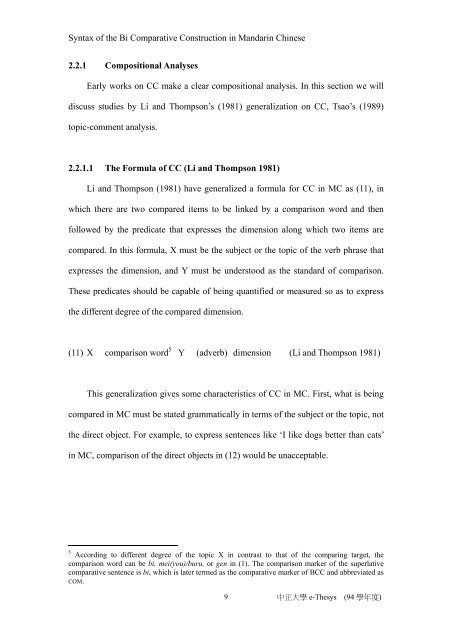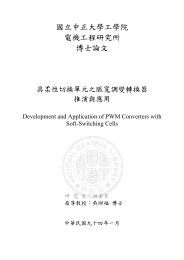Syntax of the Bi Comparative Construction in Mandarin Chinese
Syntax of the Bi Comparative Construction in Mandarin Chinese
Syntax of the Bi Comparative Construction in Mandarin Chinese
You also want an ePaper? Increase the reach of your titles
YUMPU automatically turns print PDFs into web optimized ePapers that Google loves.
<strong>Syntax</strong> <strong>of</strong> <strong>the</strong> <strong>Bi</strong> <strong>Comparative</strong> <strong>Construction</strong> <strong>in</strong> Mandar<strong>in</strong> Ch<strong>in</strong>ese<br />
2.2.1 Compositional Analyses<br />
Early works on CC make a clear compositional analysis. In this section we will<br />
discuss studies by Li and Thompson’s (1981) generalization on CC, Tsao’s (1989)<br />
topic-comment analysis.<br />
2.2.1.1 The Formula <strong>of</strong> CC (Li and Thompson 1981)<br />
Li and Thompson (1981) have generalized a formula for CC <strong>in</strong> MC as (11), <strong>in</strong><br />
which <strong>the</strong>re are two compared items to be l<strong>in</strong>ked by a comparison word and <strong>the</strong>n<br />
followed by <strong>the</strong> predicate that expresses <strong>the</strong> dimension along which two items are<br />
compared. In this formula, X must be <strong>the</strong> subject or <strong>the</strong> topic <strong>of</strong> <strong>the</strong> verb phrase that<br />
expresses <strong>the</strong> dimension, and Y must be understood as <strong>the</strong> standard <strong>of</strong> comparison.<br />
These predicates should be capable <strong>of</strong> be<strong>in</strong>g quantified or measured so as to express<br />
<strong>the</strong> different degree <strong>of</strong> <strong>the</strong> compared dimension.<br />
(11) X comparison word 5 Y (adverb) dimension (Li and Thompson 1981)<br />
This generalization gives some characteristics <strong>of</strong> CC <strong>in</strong> MC. First, what is be<strong>in</strong>g<br />
compared <strong>in</strong> MC must be stated grammatically <strong>in</strong> terms <strong>of</strong> <strong>the</strong> subject or <strong>the</strong> topic, not<br />
<strong>the</strong> direct object. For example, to express sentences like ‘I like dogs better than cats’<br />
<strong>in</strong> MC, comparison <strong>of</strong> <strong>the</strong> direct objects <strong>in</strong> (12) would be unacceptable.<br />
5 Accord<strong>in</strong>g to different degree <strong>of</strong> <strong>the</strong> topic X <strong>in</strong> contrast to that <strong>of</strong> <strong>the</strong> compar<strong>in</strong>g target, <strong>the</strong><br />
comparison word can be bi, mei(you)/buru, or gen <strong>in</strong> (1). The comparison marker <strong>of</strong> <strong>the</strong> superlative<br />
comparative sentence is bi, which is later termed as <strong>the</strong> comparative marker <strong>of</strong> BCC and abbreviated as<br />
COM.<br />
9<br />
中正大學 e-Thesys (94 學年度)





